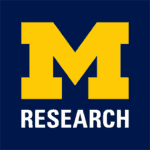
Upcoming Events
Past Events
Introduction to Artificial neural networks and Machine Learning with a few applications to Quantum Physics
The first part of this talk will present some basic aspects of simple artificial neural networks and machine learning (ML). This part would be suitable for students not familiar with the subject. The second part of this talk will briefly summarize some of our results applying ML to the study of a few problems in quantum physics and quantum information. The relevant publications are listed below. Additional applications are described in our web site: https://dml.riken.jp/pub/ai_meets_qp/
Bio:
The research group of Franco Nori (Riken and University of Michigan) has done pioneering interdisciplinary studies at the interface between quantum optics, quantum information processing, superconducting quantum circuitry for quantum computing, photonics, atomic physics, nano-mechanics, opto-mechanics, nanoscience, dissipative quantum open systems, computational physics, complex systems, and condensed matter physics.
His research group has produced numerous highly cited papers (i.e., top 1% most cited publications among all papers in all areas of Physics) according to the Web of Science. Also, about 150 publications in Physical Review Letters, > 80 in Science and Nature journals, as well as numerous ones in other top journals. According to the Web of Science: ~78K citations and h-index > 126 (Google Scholar: > 108,000 citations and h-index ~147).
He has been listed by the Web of Science as a “Highly Cited Researcher” in Physics (covering all areas of Physics) for the past eight consecutive years: from 2017 to 2024 (Less than 0.1% of physicists are selected).
He is an Elected Fellow of the: American Physics Society (APS), UK’s Institute of Physics (IoP), American Association for the Advancement of Science (AAAS), and Optical Society of America (OSA) [this last one “for fundamental contributions to quantum information science and optics, including circuit quantum electrodynamics, and the interface between quantum optics and quantum circuits”]. He received the 2014 Prize for Research in Physics, from the Matsuo Foundation, Japan; and the 2013 Prize for Science, by the Minister of Education, Culture, Sports, Science and Technology, Japan. Also, an “Excellence in Research Award” and an “Excellence in Education Award” from the University of Michigan. He is an Elected Member of the Academia Europaea, the Latin American Academy of Sciences, and a Foreign Member of the Swedish Royal Society of Arts and Sciences, in Gothenburg, Sweden. He won the 2023 W.E. Lamb Medal, and the 2024 Charles H. Townes Medal (from the OSA, now Optica); both for fundamental contributions to research on Quantum Optics, Quantum Electronics, and Quantum Information. In June 2024, he received a Research Doctorate Honoris Causa (i.e., an Honorary Doctorate) in Physics, from the University of Messina, Italy, founded in 1548.
Winter 2025 Seminar Series
Coupling control and quantum dynamics of spin defects in solids: from room temperature quantum sensing to quantum computation
Michael Flatté, Professor of physics and astronomy at the University of Iowa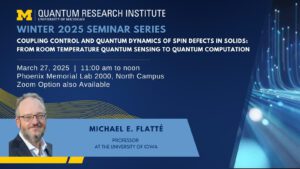
March 27, 11:00 am – noon
Phoenix Memorial Lab 2000, North Campus
———-
Quantum Gas of Molecules
Jun Ye, Professor Adjoint • Fellow – JILA at the University of Colorado Boulder
March 13, 11:00 am – noon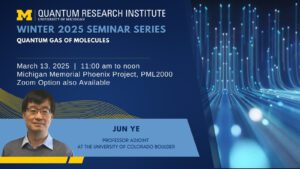
Michigan Memorial Phoenix Project, PML2000
Increasingly sophisticated quantum state engineering and high-fidelity observation of molecules are providing new opportunities to study complex structure and emergent quantum properties and to set new bounds for fundamental symmetry. In particular, quantum gases of molecules constitute a new experimental platform for precise control of molecular interactions and collective dynamics. External electric fields are used to tune elastic collision, suppress reactive loss, produce sharp interaction resonance, and control evaporative cooling. Confining molecules in optical traps with tunable spatial geometries allows realization of stereo chemistry and tunable many-body spins for quantum magnetism. Hamiltonian engineering is paving the way for production of entangled molecules that will benefit precision measurement.
Bio:
Jun Ye is a Fellow of JILA, a Fellow of NIST, and a member of the National Academy of Sciences. His research focuses on the development of new tools for light-matter interactions and their scientific applications for precision measurement, quantum science, and frequency metrology. He is known for developing highly precise and accurate atomic clocks, first realization of quantum gas of polar molecules, and pioneering work on frequency combs and spectroscopy. He is a highly cited researcher for every year since 2014. He has received numerous honors include five Gold Medals from the US Department of Commerce, Breakthrough Prize in Fundamental Physics, Micius Prize, Herbert Walther Award, Vannevar Bush Fellowship, N.F. Ramsey Prize, and I.I. Rabi Prize. The group web page is http://jila.colorado.edu/YeLabs/.
———-
Nonequilibrium Quantum Dynamics on Quantum Simulators: From Ergodicity Breaking to Quantum Metrology
Jacob Lin, RQS (Robust Quantum Simulation) postdoctoral fellow at the University of Maryland
February 27, 11:00 am – noon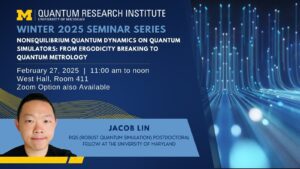
West Hall 411
The development of quantum computers and simulators has opened new avenues for studying nonequilibrium quantum many-body dynamics through quantum simulation. In this talk, I will discuss how quantum simulation has deepened our understanding of quantum many-body chaos, thermalization, and their breakdown, with a focus on ergodicity breaking due to quantum many-body scar states. I will then discuss a recently proposed nonequilibrium quantum phase—strong-to-weak spontaneous symmetry breaking—uncovered through quantum simulations of open quantum systems. Finally, driven by the potential applications of weak ergodicity breaking and quantum simulators in quantum metrology, I will highlight our recent efforts to combat the noise in quantum metrology.
Bio:
Dr. Cheng-Ju Lin is an RQS (Robust Quantum Simulation) postdoctoral fellow at the University of Maryland. He received his Ph.D. in physics from Caltech and was a postdoctoral researcher at the Perimeter Institute before his current position. His research lies at the intersection of quantum information and condensed matter physics, focusing on quantum simulations of nonequilibrium dynamics—including quantum ergodicity, its breakdown, and nonequilibrium quantum phases—as well as their applications in quantum technology.
———-
Special QRI Seminar: Cavity electrodynamics of integrated quantum materials
Hope Bretscher, Postdoc at the Max Planck Institute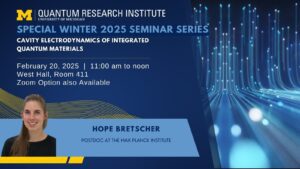
February 20, 11:00 am – noon
West Hall 411
Abstract:
Quantum materials embedded into devices have been observed to host a wide variety of quantum phases that can exhibit intriguing properties, like dissipationless transport, magnetism, or fractionalized carriers. Understanding the conditions under which these phenomena emerge is of great fundamental interest and important for deterministically designing materials for new applications. In these device-integrated quantum materials, the macroscopic responses are not solely due to the intrinsic interactions of the materials. Instead, these interactions, and the resulting ground state physics, are modified by the specifics of the device integration.
In this talk, I will discuss how integrated quantum materials form sub-wavelength cavities due to their micron-size, confining low-energy light into the near field. I will introduce time-domain on-chip THz spectroscopy as a technique to capture the cavity electrodynamics, probing the response of integrated materials to light on their natural frequency (~THz/meV) scales. This technique overcomes the mismatch between free-space THz wavelengths (~300 um) and sample size (~10 um) by measuring the optical conductivity on-chip, in the near field, and at finite momenta. I will illustrate how the properties of integrated quantum materials, such as gate-tunable van der Waals heterostructures, can be modified and controlled due to cavity effects. Using on-chip THz spectroscopy, I observed light-matter hybridization in a gate-tunable van der Waals heterostructure, between plasmonic self cavity modes in monolayer graphene and a graphite electrostatic gate. This hybridization can be tuned into the ultrastrong coupling regime using electrostatic gating and the cavity geometry. In this regime, light-matter coupling can be wielded to engineer new thermodynamic ground states. Together, these results lay a path for utilizing integrated quantum materials in novel THz quantum technologies.
Bio:
Hope Bretscher is currently a Marie Skłodowska-Curie postdoctoral fellow at the Max Planck Institute for the Structure and Dynamics of Matter, in Hamburg Germany, where she investigates the low-energy electrodynamics of 2D materials. Originally from St. Louis Missouri, Hope received her BA in physics from the University of Chicago. Funded by a Marshall Scholarship, she pursued a master’s degree in Science and Technology studies from the University of Edinburgh, before attaining her PhD in 2021 on ultrafast dynamics in vdW materials from the University of Cambridge.
———-
The invisible drummer: A quantum optomechanical dark matter search
Dalziel Wilson, Associate Professor of Optical Sciences at the University of Arizona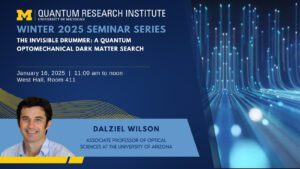
January 16, 11:00 am – noon
West Hall 411
Abstract:
Recently the field of cavity optomechanics has entered the search for dark matter, leveraging technology capable of force measurements at or below the standard quantum limit. I’ll describe one such journey, in our lab, in which a membrane-based optomechanical system is being used to search for inertial forces produced by ultralight “dark photon” dark matter. Along the way, we have developed techniques to enhance sensitivity using tools of contemporary cavity optomechanics, including elastic strain-engineering to reduce mechanical loss, radiation pressure feedback to reduce thermal noise, and photonic crystal patterning to increase displacement sensitivity. We have also joined forces with the squeezed light metrology community, to develop a prototype entanglement-enhanced optomechanical sensor array. Against this backdrop, I’ll present our initial dark photon search results.
Fall 2024 Seminar Series
From Classical to Quantum and Back: Optimizing Quantum Algorithms for Next-Generation Quantum Chemistry
Artur Izmaylov, Professor of Chemistry at the University of Toronto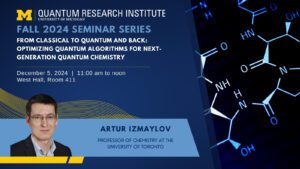
December 5, 11:00 am – noon
West Hall, Room 411
Abstract:
Bio:
Artur Izmaylov is a Professor at the University of Toronto, with appointments in the Departments of Chemistry and Physical and Environmental Sciences. He specializes in theoretical and computational chemistry, focusing on the development of innovative quantum chemistry methods. His research covers quantum dynamics, electronic structure theory, and leveraging quantum computing to tackle challenging quantum many-body problems. These problems include determining electronic states and properties of strongly correlated molecules and solids, modeling non-adiabatic molecular dynamics, and predicting non-equilibrium stationary states of open quantum systems. Prof. Izmaylov has made significant contributions to efficient state preparation techniques, such as Qubit Coupled Cluster theory, and advanced quantum measurement strategies. His work has also provided critical insights into the role of geometric phases in non-adiabatic dynamics. These achievements received prestigious awards, including the Sloan Fellowship (2015), Ontario Early Researcher Award (Canada, 2017), Tom Ziegler Award (Canadian Society for Chemistry, 2019), Journal of Physical Chemistry Lectureship Award (ACS, 2019), and the Google Quantum Research Award (2019). His group currently focuses on developing error-corrected quantum algorithms and exploring quantum-inspired techniques for classical computation.
__________
Quantum sensing with superconducting qubits
Kater Murch, Professor of Physics at Washington University in St. Louis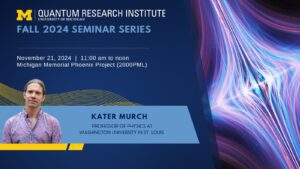
November 21, 11:00 am – noon
Michigan Memorial Phoenix Project (2000PML)
Abstract:
Josephson junction-based quantum circuits have enabled broad exploration into open quantum systems in the microwave frequency domain. The combination of coherent quantum bits, robust single qubit control, entangling gates, and quantum noise-limited parametric amplifiers has yielded an unprecedented view into the physics of quantum measurement and dissipation. I will discuss our recent experimental work that focuses on harnessing entangled states to perform measurements beyond the capabilities of unentangled sensors. Key topics will include discussion of an entanglement-enabled probe of non-Markovian dynamics and time-travel-inspired metrology protocols.
Bio:
Kater Murch is an experimental physicist and professor in the Department of Physics at Washington University in St. Louis. His research focuses on quantum measurement and quantum information science, particularly exploring the boundary between quantum and classical physics. Murch received his Ph.D. in Physics from the University of California, Berkeley in 2008. After completing postdoctoral research at UC Berkeley, he joined the faculty at Washington University in St. Louis in 2013. At WashU, Murch leads a research group that investigates quantum measurement and control of superconducting quantum circuits. Some of their notable work includes experiments on quantum trajectory theory, quantum feedback, and weak measurement. Murch is currently co-director for the Center for Quantum Sensors at WashU and a board member of the Quantum Energy Initiative.
__________
Unveiling the Invisible: Quantum Defects, Hidden Orders, and the Quest for Dark Matter
Sinéad M. Griffin, Staff Scientist at the Berkeley Lab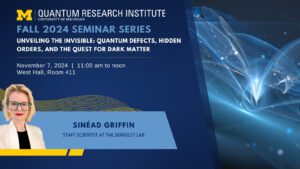
November 7, 11:00 am – noon
West Hall, Room 411
Abstract:
At the heart of scalable quantum technologies are interconnected physical systems composed of precisely tailored materials, often operating at their classical and quantum limits. In this talk, I will present our advances in developing and applying theoretical and computational approaches to tackle the unique challenges of predicting and designing quantum phenomena in solid-state systems, connecting atomic-scale information with macroscopic functionality. I will showcase select examples from our group, including the ab initio design of solid-state quantum defects through the establishment of the “Quantum Defects Genome,” leveraging high-throughput materials genomics with state-of-the-art computational techniques. Next, I will discuss our proposal of how emergent phenomena in quantum materials—such as topology, multiferroicity, and superconductivity—are promising platforms for novel quantum sensing schemes aimed at detecting elusive dark matter. I will demonstrate how designer Hamiltonian approaches offer new concepts and enhanced sensitivities for low-mass dark matter detection. Lastly, I will present recent results from our group on the extension of this approach to experimental probes sensitive to ‘hidden’ order parameters, such as the newly proposed ‘altermagnets’, and discuss how these probes provide new quantitative insights into underlying fundamental physics through correlated spectroscopies and microscopies.
Bio:
Dr. Sinéad M. Griffin is a Staff Scientist in the Materials Sciences Division and Molecular Foundry at Berkeley Lab where she leads the quantum materials theory group. Dr. Griffin received her PhD from ETH Zürich in 2014. From 2015-18 she was an SNF postdoctoral fellow at UC Berkeley and Berkeley Lab, before becoming staff scientist. Dr. Griffin’s awards include the Swiss Physical Society Award for General Physics, the Berkeley Lab Director’s Award for Exceptional Scientific Achievement, and the IUPAP Early Career Scientist Prize in Computational Physics. She is also actively involved in promoting science in Africa, and since 2010 has lectured throughout the continent as part of the African School on Electronic Structure: Theory and Applications (ASESMA).
__________
An optical tweezer array in a cryogenic environment
Cindy Regal, Professor, Baur-SPIE Endowed Chair in Optical Physics and Photonics at University of Colorado Boulder
October 24, 11:00 am – noon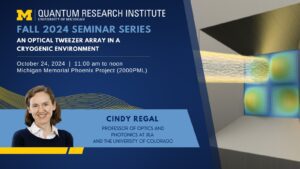
Michigan Memorial Phoenix Project (2000PML)
Abstract:
__________
Attosecond goes quantum in solids
Michael Krueger, Assistant Professor / Senior Lecturer
Department of Physics and Solid State Institute
Technion at Israel Institute of Technology
October 17, 11:00 am – noon | West Hall, Room 411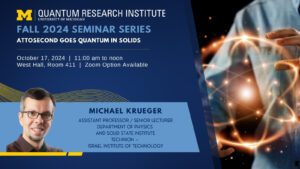
Abstract:
Attosecond physics looks into ultrafast light-matter interactions, with high-harmonic generation (HHG) as its hallmark effect. It relies on intense classical (coherent-state) laser light with large photon numbers, while quantum optics usually operates with low photon numbers and non-classical quantum states. In my talk, I will present two works that bridge between attosecond physics and quantum optics. In the first work, we successfully replace the classical (coherent-state) laser pulses by intense non-classical light – bright squeezed vacuum (BSV) – to drive HHG in solids. We show how the BSV’s extremely noisy photon statistics is transferred to its harmonics, leading to a strong enhancement of the harmonic yield and enabling studies of electron-hole dynamics at extreme intensities. In a second work, we measure the Wigner function of a harmonic driven by classical (coherent-state) light in the non-perturbative regime, showing that the quantum state of the harmonic is not trivial. Our work bears the prospect of extending the frontier of quantum optics and non-classical light into the extreme-ultraviolet spectral regime.
Bio:
Dr. Michael Krueger joined the Technion as an assistant professor of Physics in 2019. He received his Ph.D. from the Ludwig Maximilian University in Munich, Germany, in 2013. From 2014 to 2019, he performed postdoc research at the Weizmann Institute in Rehovot, Israel. In his research, Michael studies ultrafast quantum phenomena on the nanoscale. His main scientific achievements resulting from his Ph.D. have laid the foundation for the integration of attosecond science and nanoscience. This advancement could lead to novel microscopy approaches with extreme time resolution. For his Ph.D. work, Michael received the Otto Hahn Medal of the Max Planck Society in 2015. For his research at Technion, he has been awarded with a Starting Grant of the European Research Council.
Prof. Cappellaro is an expert in NMR, ESR, coherent control and quantum information science. She is a specialist in spin-based quantum information processing and precision measurements in the solid state. With collaborators, she developed the concept and first demonstrations of NV-diamond magnetometers. Cappellaro’s major contributions have been in developing control techniques for nuclear and electronic spin qubits, including NV-diamond, inspired by NMR techniques and quantum information ideas. The goal is the realization of practical quantum nano-devices, such as sensors and simulators, more powerful than their classical counterparts, as well as the acquisition of a deeper knowledge of quantum systems and their environment. Her work has been recently recognized by the Young Investigator Award from the Air Force Office of Scientific Research and a Merkator Fellowship.
__________
Engineering Robust Quantum Systems with Quantum Control
Paola Cappellaro, Professor of Nuclear Science and Engineering, Professor of Physics at Massachusetts Institute of Technology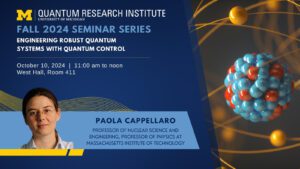
October 10, 11:00 am – noon
West Hall, Room 411
Abstract:
Quantum devices could perform some informational tasks with much better performances than classical systems, with profound implications for cryptography, chemistry, material science, and many areas of physics. However, to reach this goal we need to control large quantum systems, where the many-body dynamics might scramble the quantum information, heating up the system to its thermal state.
There are then two key questions:
- How does a closed quantum system thermalize (thus losing its “quantum power”)?
- How can we preserve quantum information in the presence of strong interactions, disorder and noise?
Using spins as an exemplary experimental system, I will show how to choreograph their dynamics in order to prevent the system from heating up, even in the presence of strong interactions among spins. I will further show how we can turn disorder from a source of noise to a tool that enables probing the system at the angstrom level. An exemplary application is the creation and characterization of a robust time crystal.
Bio:
Paola Cappellaro is Professor of Nuclear Science and Engineering at the Massachusetts Institute of Technology and a member of the Research Lab for Electronics, where she leads the Quantum Engineering Group. She received her Ph.D in 2006 from MIT and she then joined Harvard University as a postdoctoral associate in the Institute for Theoretical Atomic, Molecular and Optical Physics (ITAMP), before going back to MIT as a faculty in 2009.
Prof. Cappellaro is an expert in NMR, ESR, coherent control and quantum information science. She is a specialist in spin-based quantum information processing and precision measurements in the solid state. With collaborators, she developed the concept and first demonstrations of NV-diamond magnetometers. Cappellaro’s major contributions have been in developing control techniques for nuclear and electronic spin qubits, including NV-diamond, inspired by NMR techniques and quantum information ideas. The goal is the realization of practical quantum nano-devices, such as sensors and simulators, more powerful than their classical counterparts, as well as the acquisition of a deeper knowledge of quantum systems and their environment. Her work has been recently recognized by the Young Investigator Award from the Air Force Office of Scientific Research and a Merkator Fellowship.
__________
New Platforms for Quantum Sensing and Quantum Computing
Nathalie de Leon, Associate Professor of Electrical and Computer Engineering at Princeton University
September 26, 11:00 am – noon
Michigan Memorial Phoenix Project (2000PML)
Abstract:
The nitrogen vacancy (NV) center in diamond exhibits spin-dependent fluorescence and long spin coherence times under ambient conditions, enabling applications in quantum information processing and sensing. NV centers near the surface can have strong interactions with external materials and spins, enabling new forms of nanoscale spectroscopy. However, NV spin coherence degrades within 100 nanometers of the surface, suggesting that diamond surfaces are plagued with ubiquitous defects. I will describe our recent efforts to correlate direct materials characterization with single spin measurements to devise methods to stabilize highly coherent NV centers within nanometers of the surface. We deploy these coherent shallow NV centers for a new nanoscale sensing technique, whereby we use covariance measurements of two or more NV centers to measure two-point magnetic field correlators.
Our approach for correlating surface spectroscopy techniques with single qubit measurements to realize directed improvements is generally applicable to many systems. Separately, I will describe our recent efforts to tackle noise and microwave losses in superconducting qubits. Building large, useful quantum systems based on transmon qubits will require significant improvements in qubit relaxation and coherence times, which are orders of magnitude shorter than limits imposed by bulk properties of the constituent materials. This indicates that loss likely originates from uncontrolled surfaces, interfaces, and contaminants. Previous efforts to improve qubit lifetimes have focused primarily on designs that minimize contributions from surfaces. However, significant improvements in the lifetime of planar transmon qubits have remained elusive for several years. We have recently fabricated planar transmon qubits that have both lifetimes and coherence times exceeding 0.3 milliseconds by using tantalum as the material in the capacitor. Following this discovery, we have parametrized the remaining sources of loss in state-of-the-art devices using systematic measurements of the dependence of loss on temperature, power, and geometry. This parametrization, complemented by direct materials characterization, allows for rational, directed improvement of superconducting qubits.
Bio:
Nathalie de Leon is an associate professor of Electrical and Computer Engineering at Princeton, where she focuses on quantum sensing with NV centers in diamond, quantum networks with solid state defect systems and nanophotonics, and new material platforms for superconducting qubits. She received her BS from Stanford University in 2004 and PhD from Harvard University in 2011. She then worked as a CIQM and Element Six postdoctoral fellow at Harvard. Nathalie joined the faculty of Princeton University as an assistant professor in Electrical and Computer Engineering in 2016, where she was later promoted to associate professor. Her group works at the interface of quantum optics, atomic physics, condensed matter and device physics, materials science, surface spectroscopy, nanofabrication, and spin physics to uncover sources of noise and loss in quantum systems, and uses these insights to design new quantum platforms. She is currently the materials thrust leader of the Co-design Center for Quantum Advantage, a DOE National Quantum Information Science Center, and she was elected as Vice Chair of the APS Division of Quantum Information in 2024. Nathalie received the Air Force Office for Scientific Research Young Investigator Award in 2016, the Sloan Research Fellowship in Physics in 2017, the NSF CAREER Award in 2018, the DARPA Young Faculty Award in 2018, and the DOE Early Career Award in 2018, the Gordon and Betty Moore Foundation Experimental Physics Investigator Award in 2023, and the APS Rolf Landauer and Charles H. Bennett Award in Quantum Computing in 2023.
__________
Exploring Selective Radiance With Trapped Atoms on a Nanophotonic Resonator
Chen-Lung Hung, Associate Professor of Physics and Astronomy at Purdue University
September 12, 11:00 am – noon
West Hall, Room 411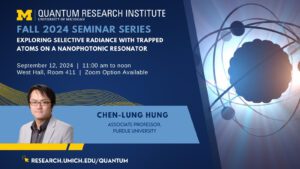
Abstract:
Control and manipulation of the collective radiative states of atomic systems could bring new opportunities for quantum many-body physics and quantum networks. In this talk, I will discuss our recent investigation on “selective radiance,” a phenomenon in which an atomic excitation couples to a specific photonic channel with collective enhancement (called ‘superradiance’) but to all other channels with suppression (‘subradiance’). Following our recent experimental realization of cold atom trapping on a nanophotonic microring resonator, we study how a dense atomic ensemble collectively couples to a whispering-gallery-mode in the resonator and to other free space modes. I will discuss the decay dynamics of an atomic ensemble following long and short excitation pulses, with the former driving the system into a steady state and the latter into a so-called timed-Dicke state. I will discuss the potential of our platform to realize selective radiance in an atom array and explore collective quantum optics with trapped atoms coupled to nanophotonic circuits.
Bio:
Dr. Hung received his PhD in Physics at the University of Chicago in 2011, where he developed an in-situ microscopy technique on two-dimensional atomic quantum gases to study quantum phase transitions. Before joining Purdue in 2015 as a faculty member, he held a postdoctoral fellowship at the California Institute of Technology and developed one of the first photonic crystal atom-photon interfaces for quantum optics. His research directions at Purdue University span from studying out-of-equilibrium many-body physics using atomic quantum gases to interfacing ultracold atoms with nanophotonic circuits for quantum optics and many-body physics with photon-mediated long-range interactions. He is a recipient of the AFOSR Young Investigator Award and the NSF CAREER award.
Winter 2024 Seminar Series
Opportunities and Challenges for Diamond in Quantum Applications
Shannon Nicley, Assistant Professor in the Department of Electrical and Computer Engineering at Michigan State University (MSU)
April 18, 11:00 am – noon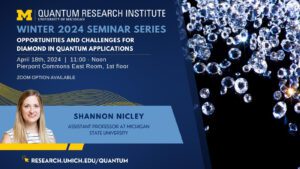
East Room (1st floor) of Pierpont Commons
Zoom option
Diamond is a highly attractive material as a solid-state host for a class of crystal defect spin-based qubits, which exhibit high stability even under ambient conditions. Carbon-12 isotopically purified diamond is also spin free, allowing for exceptionally long coherence times. I will introduce the challenges and opportunities in this field and present the results of our ongoing efforts to identify new defects in diamond with long coherence times and high-quality optical interfaces, as well as our efforts to controllably create vacancy defects in solid state systems through multiphoton femtosecond laser nanofabrication.
______________________________
Engineering of atomic and solid-state quantum emitters for sensing
Jennifer Choy, Assistant Professor at the Department of Electrical and Computer Engineering at UW–Madison April 4, 11:00 am – noon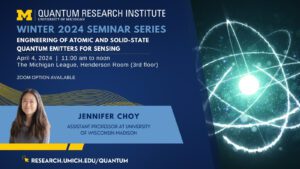
The Michigan League
Henderson Room (3rd floor)
Zoom option
I will describe the realization of quantum sensors based on two material platforms: alkali atoms such as rubidium, and spin defects in diamond. These platforms have complementary properties that make each uniquely advantageous for certain sensing applications, as well as challenges that currently limit their sensing performance and functionality. I will discuss engineering approaches to miniaturize and improve the performance of quantum sensors, including photonic-integration of atomic magnetometers, improving light-matter interactions with solid-state spin defects, and stabilization of near-surface quantum emitters through surface treatments.
______________________________
Demonstration of Algorithmic Quantum Speedup
Daniel Lidar, Viterbi Professor of Engineering at USC
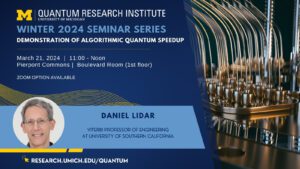 March 21, 11:00 am – noon
March 21, 11:00 am – noon
Pierpont Commons
Boulevard Room (1st floor)
Zoom option
Despite the development of increasingly capable quantum computers, an experimental demonstration of an algorithmic quantum speedup employing today’s non-fault-tolerant devices has remained elusive. In this talk, I will report on three very recent demonstrations of such a speedup, focusing on how solution times scale with problem size. Two of the demonstrations use IBM’s superconducting quantum computers and involve modified versions of foundational black-box quantum algorithms. In contrast with recent quantum supremacy demonstrations, these quantum speedups do not rely on complexity-theoretic conjectures. The third demonstration uses a D-Wave quantum annealer and involves approximate optimization in the context of spin glass problems. In all cases, our work incorporates tailored quantum error suppression methods, which we found to be necessary in order for the quantum speedup to appear.
______________________________
Quantum Optical Interconnects
Marko Lončar, Harvard’s School of Engineering and Applied Sciences (SEAS)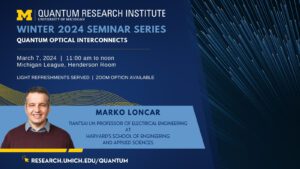
Michigan League
Henderson Room (3rd floor)
___________________________________________
Building a Quantum World with Trapped Ions
Norbert Linke, Assistant Professor of Physics at the Duke Quantum Center (DQC)
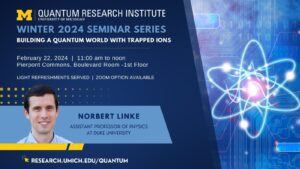
This talk will describe the development of an atomic physics experiment into a quantum computer and quantum simulator. Our system is based on a chain of 171Yb+ ions with individual laser beam addressing. This fully connected device can be configured to run any sequence of single- and two-qubit gates, making it in effect an arbitrarily programmable quantum computer. The high degree of control can be used for digital quantum circuits, but also for analog and hybrid quantum simulations, including quantum-classical optimization routines. We operate this machine in user-facility mode, working with many external collaborators and growing its capabilities with every new application. I will present recent results from a lattice gauge theory simulation. Finally, I will describe our effort towards networking ion trap quantum computers in a city-sized network for new quantum technology applications.
___________________________________________
Quantum photonics with rare-earth atoms in solids
Dr. Elizabeth Goldschmidt, Assistant Professor of Physics at the University of Illinois Urbana-Champaign.
February 8, 11 am – 12 pm
Henderson Room (3rd floor) at the Michigan League
Zoom option
Optically active and highly coherent emitters in solids are a promising platform for a wide variety of quantum information applications, particularly quantum memory and other quantum networking tasks. Rare-earth atoms, in addition to having record long coherence times, have the added benefit that they can be hosted in a wide range of solid-state materials. We can thus target particular materials (and choose particular rare-earth species and isotopes) that enable certain application-specific functionalities. I will give an overview of this promising field and discuss several ongoing projects with rare-earth atoms in different host materials and configurations. This includes efforts to identify and grow new materials with rare-earth atoms at stoichiometric concentrations in order to reduce disorder-induced inhomogeneous broadening, as well as photonic integration of rare-earth doped samples to increase the light-atom interaction for practical quantum devices.
___________________________________________
Nanoscale electron paramagnetic resonance and quantum opto-mechanics with diamond spin qubits
January 25, 11 am
Pierpont Commons, Boulevard Room (1st Floor Mazznine)
Gurudev Dutt, Associate Professor at the University of Pittsburgh, will be presenting “Nanoscale electron paramagnetic resonance and quantum opto-mechanics with diamond spin qubits” as part of the Quantum Research Institute’s winter seminar series. A Zoom option is also provided.
Seminar Description:
Single spins associated with nitrogen-vacancy (NV) defects in diamond have emerged as a promising and versatile experimental platform for quantum information processing. They can be used as nodes in optically connected quantum networks, as sensors for magnetic imaging with sub-micron resolution, for detecting and engineering quantum states of nano-mechanical oscillators, and even as probes in biological systems. Our group has demonstrated improvements to dynamic range and sensitivity of magnetometry using phase estimation algorithms, and carried out electron paramagnetic resonance detection and spectroscopy of single Cu ions on the diamond surface. I will also discuss a unique system in our lab where we magnetically trap and laser cool diamond microcrystals under high-vacuum room-temperature conditions for the first time, and discuss the path forward to observing quantum superpositions of macroscopically separated motional states.
Fall 2023 Seminar Series

Quantum-enhanced interferometric imaging: A step toward quantum-enhanced very-long-baseline interferometry for astronomy – 11/30/23
Dr. Brian Smith, Professor of Physics at the University of Oregon, will be presenting “Quantum-enhanced interferometric imaging: A step toward quantum-enhanced very-long-baseline interferometry for astronomy” as part of the Quantum Research Institute’s fall seminar series from 11am – noon in the Hussey Room (2nd floor) at the Michigan League on Thursday, November 30th. A Zoom option is also provided.
Seminar Description:
We report a laboratory demonstration of interferometric imaging using a path-entangled single-photon state as a reference field distributed to spatially separated receivers to measure the spatial distribution of an extended incoherent source. The use of distributed entanglement between the receiving stations in this protocol allows measurements without requiring direct interference of the collected light and provides a route to larger baseline separations that could enhance the precision of astronomical telescopes.
___________________________________________
Phononic Bath Engineering of a Superconducting Qubit – 11/16/23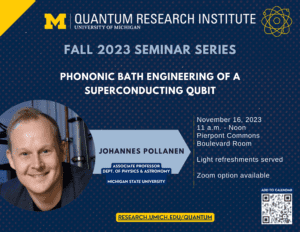
Dr. Johannes Pollanen, Associate Professor in the department of Physics and Astronomy at Michigan State University, will be presenting “Phononic Bath Engineering of a Superconducting Qubit” as part of the Quantum Research Institute’s fall seminar series from 11am – noon in the Boulevard Room (1st mezzanine floor) at Pierpont Commons on Thursday, November 16th. A Zoom option is also provided.
Seminar Description:
Interactions between a quantum system and its environment typically lead to unwanted decoherence and dissipation. However, if the environmental degrees of freedom can be sufficiently well understood, or even engineered, dissipation can be harnessed for the preparation and manipulation of such open quantum systems. In this talk I will discuss our recent results investigating a novel open quantum system composed of a superconducting transmon qubit coupled to surface piezophonon devices. In this hybrid quantum system we are able to engineer dissipation in the form of tailor-made phononic loss to control quantum information states of the qubit.
___________________________________________
Emerging Materials for Quantum Technologies – 11/2/2023
 Dr. Yong P. Chen, Karl Lark-Horovitz Professor of Physics and Astronomy at Purdue and Director of the Purdue Quantum Science and Engineering Institute, will be presenting “Emerging Materials for Quantum Technologies” as part of the Quantum Research Institute’s fall seminar series from 11am – noon in the Kalamazoo Room (2nd floor) at the Michigan League on Thursday, November 2nd. A Zoom option is also provided.
Dr. Yong P. Chen, Karl Lark-Horovitz Professor of Physics and Astronomy at Purdue and Director of the Purdue Quantum Science and Engineering Institute, will be presenting “Emerging Materials for Quantum Technologies” as part of the Quantum Research Institute’s fall seminar series from 11am – noon in the Kalamazoo Room (2nd floor) at the Michigan League on Thursday, November 2nd. A Zoom option is also provided.
Seminar Description:
This seminar will discuss some emerging materials — particularly in the space of 2D/layered and topological materials ranging from 2D semiconductors to topological insulators — and their promising properties and potential uses in quantum technologies.
___________________________________________
Quantum Research Institute seminar on 10/19: Linran Fan
The third event in the Quantum Research Institute’s Fall 2023 seminar series will be from Dr. Linran Fan, Assistant Professor in the Chandra Family Department of Electrical and Computer Engineering at The University of Texas at Austin.
Dr. Fan’s talk, titled “Hybrid Integrated Photonics for Quantum Information Processing” will take place on Thursday, Oct 19th from 11am – noon in the Boulevard Room (1st floor mezzanine) at Pierpont Commons. A Zoom option is also provided.
Photonics will play a central role in future quantum technology, offering the unique and indispensable capability to conserve quantum coherence over long distances and inter-connect different quantum systems. This talk will present our efforts in developing hybrid integrated photonic platforms, which enable the exploration of new quantum phenomena, the development of novel quantum information functions, and the improvement of quantum device performance.
___________________________________________
Quantum Research Institute seminar on 10/5: Amit Agrawal

The second event in the Quantum Research Institute’s Fall 2023 seminar series will be from Dr. Amit Agrawal, project leader of the Ultrafast Nano-Optics Group within the Physical Measurement Laboratory at the National Institute of Standards and Technology.
Dr. Agrawal’s talk, titled ” Integrated Optical Control of Atomic Quantum Systems” will take place on Thursday, Oct 5th from 11am – noon in the Kalamazoo Room (2nd floor) at the Michigan League. A Zoom option is also provided.
Seminar Description:
Optical control of quantum matter – from trapped atoms and ions to quantum dots and defects, is foundational for quantum information science and technology. Development of integrated photonics opens the possibility for realization of scalable circuits with complex functionalities, advancing both science and technology frontiers and enabling real-world applications in quantum sensing and precision measurements. Here, we present our work on scalable, robust and multifunctional nanophotonic interfaces to trap neutral atoms or address trapped ions. Our nanophotonic platform, replacing bulk optical elements, promises increased complexity and functionality in a batch-fabricated optical microsystem ultimately fully replacing the laboratory optical table to enable cold atom clocks and quantum computers.
___________________________________________
 Co-Designed Quantum Error Correction: Liang Jian – 9/21/23
Co-Designed Quantum Error Correction: Liang Jian – 9/21/23
Dr. Jiang’s talk, titled “Co-Designed Quantum Error Correction” will take place on Thursday, Sept 21st from 11am – noon in the Boulevard Room (1st floor) at Pierpont Commons (North Campus). A Zoom option is also provided.
Seminar Description:
Our goal is to design quantum error correction schemes that suppress hardware-specific errors while meeting diverse application needs. This presentation covers the design of error-correcting codes that effectively handle practical errors, including custom schemes for AMO and solid-state platforms, as well as applications in quantum computing, communication, and sensing.
Contact Us
Email the Quantum Research Institute: [email protected]
